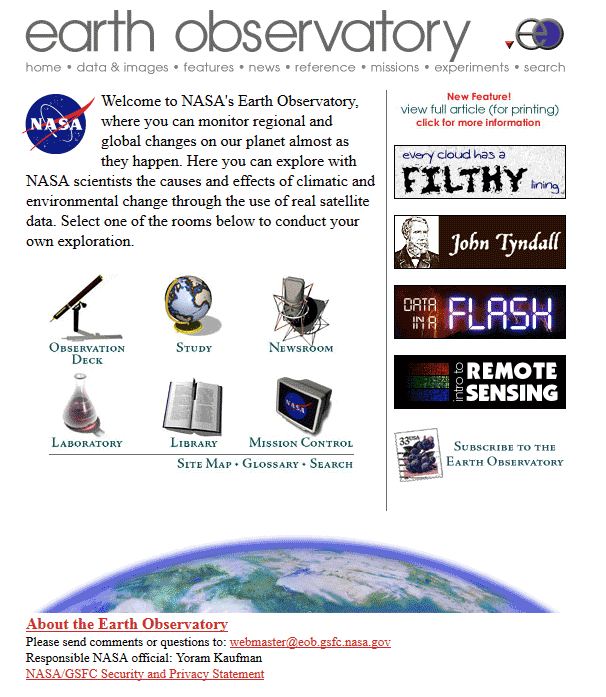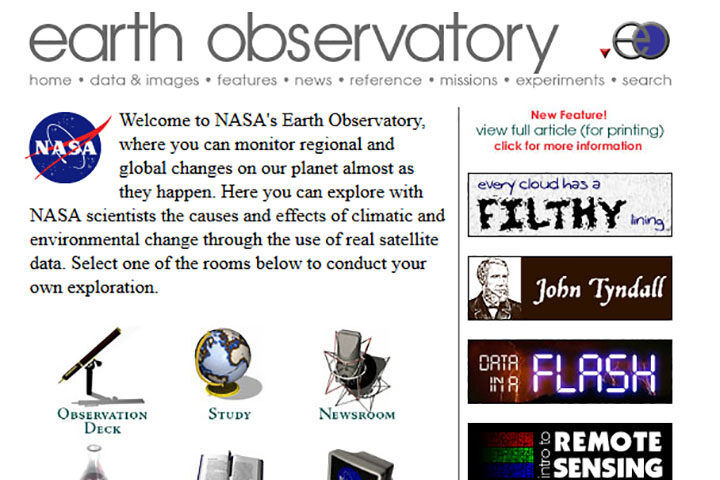On April 29, 1999, NASA Earth Observatory (EO) started delivering science stories and imagery to the public through the Internet. So much has changed in those 20 years…
+ In 1999, about 3 to 5 percent of the world had Internet access. About 41 percent of American adults used the World Wide Web, most often to look at the weather. Today an estimated 56 percent of the world’s population (4.3 billion people) are active on the Internet.
+ At the end of the 20th century, all EO readers came to us through a computer, mostly desktops. One third of them were connecting via dial-up modem. Today, about 40 percent of our audience arrives to the web site via mobile phones and tablets on public wifi and cellular networks. Yet even now, 65,000 of our most loyal followers subscribe to our newsletters. Many others subscribe to our RSS feeds.

+ In 1999, “social” media mostly consisted of chatrooms and newsgroups. Even by 2005, only 5 percent of Americans were using social media. Today about 69 percent of adults use social media, and people are just as likely to see Earth Observatory content on social platforms as on our web site. Ten million people follow EO and NASA Earth science on Facebook, with 1.3 million more on Twitter, and 500,000 on Instagram.
+ When EO launched, images from Earth science satellites were generally available about a month after acquisition. Public access to science data and imagery was extremely limited, highly filtered, and sometimes required a fee. Two decades later, many NASA Earth science observations are available freely on the web within hours of acquisition.
+ On our first day online, the site got 400 pageviews–most of them were likely colleagues and relatives. Today we get about 50,000 views per day.

+ In our first year, we published 35 “Images of the Week” and 9 feature stories. By 2001, we started delivering an Image of the Day. Since launch, we have published more than 6,900 Images of the Day, 8,300 natural hazards images, and 450 features and videos. Yes, more than 15,000 image-driven stories, and all of them are still available in our archive.
+ In 1999, two members of our staff were in elementary school and three were in high school. The readers of EO Kids were not born yet.
The technology of science and the Internet has changed in a generation, and our site has evolved and grown with the changes. But our core values have not changed. You find us on more platforms and with some new approaches, but you can still count on us to deliver beautiful, newsworthy, interesting, and scientifically important images and stories. Our editorial team has more than 110 years of experience in science communication and data visualization, and we bring that depth of knowledge to every story, 365 days a year.
None of this would be possible without the many scientists, engineers, communicators, data hounds, patrons, and friends inside and outside of NASA who review our work, tip us off to stories and images, share their scientific insights, and inspire and challenge us. Thank you.

As we celebrate our 20th year, we are going to share some looks back and some looks ahead. In the next twelve months, look for…
- EO on This Day – a chance to see some of the most memorable Images released on each day of the calendar year
- New puzzlers, videos, and social media events
- Stories of science evolving, as we revisit images, global maps, and science stories from the past 20 years and ask “what have we learned in two decades and where do we go next?”
- Our first photo essay book, available in print, on the web, or downloadable to your tablet.
If you have been with us for many (or all) of our 20 years, thank you. We have some of the most engaged, challenging, and thoughtful readers on the planet, and we work hard to live up to your trust and interest. If you are new to the site, bring a friend. We have 15,000 stories about Earth to share, with more being added every day.
Related Links and References
Earth Observatory 10th Anniversary
Pew Research Center (2018) World Wide Web Timeline
Internet World Stats (2019) Internet Growth Statistics
Wikipedia (2019) Global Internet Usage
Tags: NASAEO20




Thank you for the fantastic job you do of keeping myself and millions of others informed about our earth and about the interactions between man and earth.
You do a fantastic job. I get your news via e-mail and I really appreciate and enjoy it.
I am a retired aerospace engineer so I am so excited to see the evolution of NASA technology.
Are your archives available to readers like me?
Thank you for sharing your achievements.
Regards,
Reg Caton
Felicidades por compartir imágenes inalcanzables; que pueden ser cotidianas para futuras generaciones.
This is my favorite and most essential NASA website. Looking forward to another 20 years. Hopefully, the updates from space will show some stewardship.
You people are doing a wonderful job and as I was reading this article about 20 years of the internet what do you think wl happen in the next 20 yrs? Also, how many billions years do we have left until the sun explodes and we all disappear but could the sun die sooner than we think about how much population and heat we produce because of the sun’s massive sunspot?